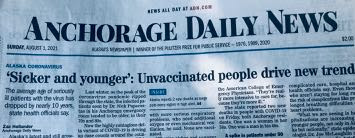I track Alaska's COVID numbers on a chart I started March 15, 2020. I also make a small summary of the numbers each day. That got too tedious to post here with the regular posts every day, so they're hidden in a tab under the banner above: Alaska Daily COVID Count 3.
The numbers continue to get worse and worse. Normally I keep the comments to a minimum and focus on the numbers. But I couldn't help myself today. This is all so avoidable, but the kids in the third grade classroom who still haven't learned to clean up after themselves and can't stand it when another kid has something that don't have (even if they don't even want it), well those kids (and their various enablers) are keeping this pandemic going.
Here's today's update. You have to actually go to the tab to see the table with all the numbers.
"Wednesday, September 1, 2021 - For all the folks complaining about how Biden got us out of Afghanistan, yet didn't really work hard to get past the 20 years of wishful thinking about how well the Afghan army and government were doing, think carefully about your beliefs that COVID is a hoax, that herd immunity will make it disappear, that younger people don't get sick or die, that masks and vaccines don't matter. You're thinking like those so focused on myths about American exceptionalism and our ability to make anything happen because ... we are America. The Alaska numbers are worse once again and it's the fault of a Governor who cares more about his agenda of cutting government and getting reelected than about the lives of Alaskans. It's the fault of people profiting from slick podcasts and websites that spread misinformation and alternative medicines that range from useless too dangerous. It's the fault of people so vested in some mythical better time in America that they believe anything that supports their false vision.
Sorry, but four more people died yesterday. That's adding to the four who died the day before. 13 more were hospitalized. Another new record of COVID hospitalizations was set: 181 or 161(20) - the (20) are COVID positive or suspected who are on Vents. That sounds like nothing, but BEING ON A VENT IS HORRIBLE! This is from Yale Medicine
"The goal is for patients to be awake and calm while they are on a ventilator, but that can sometimes be difficult; many require light sedation for comfort, Dr. Ferrante says.
“Sometimes, patients develop delirium, or an acute state of confusion. And when patients become confused, they might try to pull out their endotracheal tube, which connects them to the ventilator,” she says. “Patients with delirium can be lucid one moment and confused the next. Although we try to avoid sedation as much as possible, particularly in delirious patients, we may have to give some sedation to prevent people from causing self-harm, like pulling out the breathing tube.”
Furthermore, patients with ARDS often feel a natural instinct to take in very big breaths, Dr. Ferrante adds. “Very large breaths can be harmful to an ARDS patient’s lungs, so we try to have their breath size match what we have set on the ventilator,” she says.
Typically, most patients on a ventilator are somewhere between awake and lightly sedated. However, Dr. Ferrante notes that ARDS patients in the ICU with COVID-19 may need more heavy sedation so they can protect their lungs, allowing them to heal."
Here's another description from the Medical School at Ohio State University.
22 available ICU beds in Alaska, six in Anchorage. That's a slight improvement, thanks, I guess to the four people who died.
761/765 new resident cases. Yet another one day record for 2021. Not the kind of records we want. Also, 37 new non resident cases.
About 11,000 tests. Test Positivity dipped slightly. Yesterday was the highest TP of 2021 and today is the second highest at 7.47. You can't fly on this 747 though.
And with Matsu having the 3rd worst Alaska vaccine record at 44% (one or more shots) yet hosting the State Fair and trying to open schools without masks, be assured things are going to get worse before they get better."
Folks, it's probably not people who read this blogs. But people you know are insuring that more people get sick and die of COVID. It's a shrinking minority.
63% of US adults (18+) are fully vaccinated. That means 37% of adults are not. 63%-37% is a landslide in an election.
55% of Alaskan (12+ not 18+) are fully vaccinated. That means 45% are not. But this includes kids from 12 to 18, not just adults over 18. 55% to 45% is still a pretty decisive win in an election. If you interact with non-vaxxers, be polite. Ask them about their family life when they were kids. How well did the siblings get along? How did they get along with their parents? I suspect for many of them, that is the crux. They're still rebelling against parental authority. Whatever they are told by their parental authority substitute, they'll do the opposite.





















